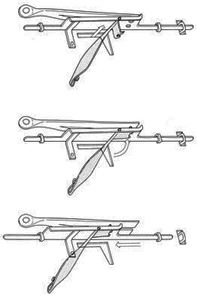

The Locks on this page would use these styles of keys:
 These are not to scale with each other.
These are not to scale with each other.


The locks on this page I refer to as "lift-spring release" locks because the key lifts the spring from a catch, then permitting a sliding bolt to be slid left or right. This style seems to be the most commonly represented by extant finds, though keys for the same are not.
The two illustrations here are clear enough demonstration of how they worked but the lock plate can be either having one hasp bolt or two. The Lock to the right utilizes the typical "hook end" bolt so sliding the bolt will engage two sperate hasps from the same direction.


One of the most famous of this form of locks, from the Mastermyr toolbox. Well preserved and preserved with tools, scrap and many other locks, it is speculated the owner of the tool kit was also a lock maker, as well as a blacksmith.
To the right is a photo the original chest. The box is approximately 35 inches in length and made of oak.
Instructions on how to build the box may be found here:
A Replica Viking Chest, based on the Mästermyr find - Steven Lowe provides drawings which will make it easier for you to decipher how to make your own replica.


This lock is off the Oseberg Banded Chest and is unique that it has two hooks permitting three hasps to be engaged. The mechanism appears to float within a carved recess independent of the metal cladding on the exterior.


This is a very well drawn example where the artist was able to give the lock close examination. What I appreciate also, is the irregularity of the lock parts. Including the exterior. In our modern machine made world, we expect everything to have straight lines and symmetry through out.




These locks follow the same pattern in their design and other than each is individually made and uniquely different.
At this point I do not have their dimensions.




To the left is my version of these locks found at Birka, though the locking mechanism of all these locks are similar. That indicates a wide distribution of use, from the Eastern Scandinavian counties to England. I built this lock with a "ward" post or peg mounted on the underside of the sliding bar, that corresponds to the square hole in the key. This prevents a different key with NO hole, to be able to engage the spring and lift it from the lock position. You do see turnkeys with the corresponding hole, (See key styles above.) which indicated to me that some were warded as such.
My thoughts:
The lock works smoothly, however, there are other styles that are simpler to construct. I have to wonder if the personality, hence unfamiliarity of the individual lock is as much as it's theft prevention as just the act of locking. These are all simple locks what could easily be "picked" but the unusual variances increased their difficulty. I doubt there were lock pick kits and having a smith with lock making experience would be unusual so maybe being "different" might be part of the challenge.